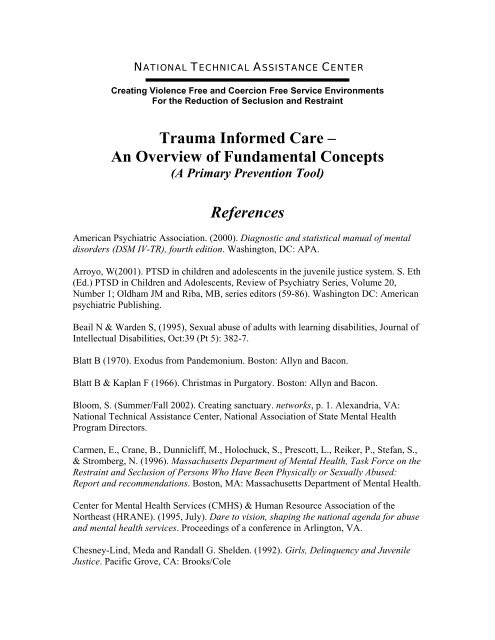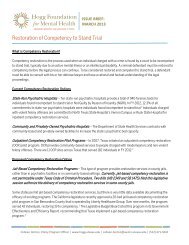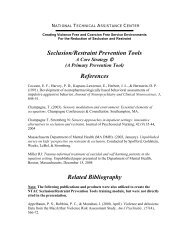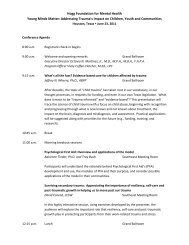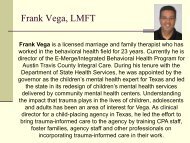Trauma-Informed Care Fundamental Concepts - Hogg Foundation ...
Trauma-Informed Care Fundamental Concepts - Hogg Foundation ...
Trauma-Informed Care Fundamental Concepts - Hogg Foundation ...
You also want an ePaper? Increase the reach of your titles
YUMPU automatically turns print PDFs into web optimized ePapers that Google loves.
NATIONAL TECHNICAL ASSISTANCE CENTERCreating Violence Free and Coercion Free Service EnvironmentsFor the Reduction of Seclusion and Restraint<strong>Trauma</strong> <strong>Informed</strong> <strong>Care</strong> –An Overview of <strong>Fundamental</strong> <strong>Concepts</strong>(A Primary Prevention Tool)ReferencesAmerican Psychiatric Association. (2000). Diagnostic and statistical manual of mentaldisorders (DSM IV-TR), fourth edition. Washington, DC: APA.Arroyo, W(2001). PTSD in children and adolescents in the juvenile justice system. S. Eth(Ed.) PTSD in Children and Adolescents, Review of Psychiatry Series, Volume 20,Number 1; Oldham JM and Riba, MB, series editors (59-86). Washington DC: Americanpsychiatric Publishing.Beail N & Warden S, (1995), Sexual abuse of adults with learning disabilities, Journal ofIntellectual Disabilities, Oct:39 (Pt 5): 382-7.Blatt B (1970). Exodus from Pandemonium. Boston: Allyn and Bacon.Blatt B & Kaplan F (1966). Christmas in Purgatory. Boston: Allyn and Bacon.Bloom, S. (Summer/Fall 2002). Creating sanctuary. networks, p. 1. Alexandria, VA:National Technical Assistance Center, National Association of State Mental HealthProgram Directors.Carmen, E., Crane, B., Dunnicliff, M., Holochuck, S., Prescott, L., Reiker, P., Stefan, S.,& Stromberg, N. (1996). Massachusetts Department of Mental Health, Task Force on theRestraint and Seclusion of Persons Who Have Been Physically or Sexually Abused:Report and recommendations. Boston, MA: Massachusetts Department of Mental Health.Center for Mental Health Services (CMHS) & Human Resource Association of theNortheast (HRANE). (1995, July). Dare to vision, shaping the national agenda for abuseand mental health services. Proceedings of a conference in Arlington, VA.Chesney-Lind, Meda and Randall G. Shelden. (1992). Girls, Delinquency and JuvenileJustice. Pacific Grove, CA: Brooks/Cole
Charlton et al, (2004). Facts on traumatic stress and children with developmentaldisabilities. National Child Stress Network: Adapted <strong>Trauma</strong> Treatment Standards WorkGroup, Subgroup on Developmental Disabilities, Durham, NC and Los Angeles, CACook, J. A., Jonikas, J. A., & Laris, A. (2002). Increasing self-determination: Advancecrisis planning with mental health consumer inpatient and other settings. Chicago, IL:University of Illinois at Chicago Mental Health Services Research Program.CSAT/SAMHSA, 2000, http://www.csat.samhsa.gov/Cusack, K. J., Frueh, B. C., Hiers, T. G., Keane, T. M., & Mueser, K. T. (Unpublishedpaper). The impact of trauma and Posttraumatic Stress Disorder upon American society,Report to the President’s Commission on Mental Health.Cusack, K. J., Frueh, B. C., Bray, KT (2004) <strong>Trauma</strong> history screening in a communitymental health center, Psychiatric Services, 155:157-162.DOC, Juvenile Justice Recidivism Baseline Report for 1998.Dedicated External Female Offender Review, Governor’s Task Force, Commonwealth ofMa., 2005Fallot, R., & Harris, M. (2002). <strong>Trauma</strong> informed services: A self-assessment andplanning protocol 1-5. Unpublished papers. Washington, DC: Community Connections.Felitti, V. J., Anda, R. F. & Nordenberg, D. (1998). Relationship of Childhood abuse andhousehold dysfunction to many of the leading causes of death in adults. The adversechildhood experiences (ACE) study. American Journal of Prevention Medicine, 14, 245-258.Ford, J. (2003, January 17). <strong>Trauma</strong> Adaptive Recovery Group Education and Therapy(TARGET). Retrieved from www.traumamatters.org/documents/TARGET--JulianFord.pdf on January 17, 2003.Garbino, J. (1999). Lost boys: Why our sons turn violent and how we can save them. NewYork: Free Press.Garland AF et al, (2001). Prevalence of psychiatric disorders in youths across five sectorsof care. Journal of the American Academy of Child and Adolescent Psychiatry, 40, 409-418Giller, E. (1999). What is psychological trauma? Sidran Institute.Gilligan, J. and Lee, B. (2004). Beyond the Prison Paradigm: From Provoking Violenceto Preventing It by Creating "Anti-Prisons" (Residential Colleges and TherapeuticCommunities). Ann NY Acad Sci. 1036: 300-324.<strong>Trauma</strong> <strong>Informed</strong> <strong>Care</strong> 2
Goodman, L. A., Dutton, M. A., & Harris, M. (1997). The relationship between violencedimensions and symptom severity among homeless mentally ill women. Journal of<strong>Trauma</strong>tic Stress, 10:51-70.Governor’s Commission on Correctional Reform: Report and Recommendations,Commonwealth of Ma, October 25, 2005.Harvey, H. G., Brant, R. A., & Tarrier, N. (2003). Cognitive behavior therapy forposttraumatic stress disorder. Clinical psychology review. 23:501-522Herman, J., Perry, C., & van der Kolk, B. (1989, April). Childhood trauma in BorderlinePersonality Disorder. Am J Psychiatry, 164(4), 490-495.Herman, J. (1992). <strong>Trauma</strong> and recovery: The aftermath of violence – from domesticabuse to political terror. New York, NY: Basic Books.Hodas, G.R. (2004). Understanding and responding to childhood trauma: Creatingtrauma informed care. Unpublished paper. Pennsylvania Office of Mental Health andSubstance Abuse Services.Jennings, A. F. (1998). Women’s mental health services: A public health perspective. InB. L. Levin, A. K. Blanch, & A. Jennings (Eds.), Being Invisible in the Mental HealthSystem, 15:326-347.Jennings, A. F. (2004). The Damaging Consequences of Violence and <strong>Trauma</strong>: Facts,Discussion points, and Recommendations for the Behavioral Health System, 19.Alexandria, VA. National Association of State Mental Health Program Directors(NASMHPD)/National Technical Assistance Center (NTAC).Jennings, A. F., & Ralph, R. O. (1997). In their own words, trauma advisory groupsreport. Augusta, ME: Maine Department of Mental Health and Mental Retardation andSubstance Abuse Services.Linehan, M. (1993). Skills training manual for treating borderline personality disorder.New York: Guilford PressLipschitz, D. et al. (1999). Posttraumatic Stress Disorder in hospitalized adolescents:Psychiatric comorbidity and clinical correlates. J. Am. Acad. Child Adolesc. Psychiatry,38:385-392.Massachusetts Department of Mental Health, (2001), Medical Record Survey, Child andAdolescent Psychiatric Inpatient Programs, DMH Restraint and Seclusion ReductionInitiative, Lebel J & Stromberg NMaine Department of Behavioral and Developmental Services (Maine BDS). (2000).Unpublished seclusion- and restraint-related documents. Augusta, ME: Maine BDS.<strong>Trauma</strong> <strong>Informed</strong> <strong>Care</strong> 3
Muesar, K. T., Goodman, L. A., Trumbetta, S. L., et al. (1998). <strong>Trauma</strong> andposttraumatic stress disorder in severe mental illness. Journal of Consulting and ClinicalPsychology, 66:493-499.Mueser, K. T., Salyers, M. P., Rosenberg, S. D., Goodman, L. A., Essock, S. M., Osher,F. C., Swartz, M. S., & Butterfield, M. (in press). Interpersonal trauma and posttraumaticstress disorder in patients with severe mental illness: Demographic, clinical, and healthcorrelates. Schizophrenia Bulletin.Najavits, L. (2003, January 17). Seeking safety. Retrieved fromwww.seekingsafety.org/3-02%20arts/training%20in%20SS-s.pdfNational Association of State Mental Health Program Directors (NASMHPD). (1998).Executive summary: Responding to the behavioral healthcare issues of persons withhistories of physical and sexual abuse. Alexandria, VA: National Association of StateMental Health Program Directors.NASMHPD/NTAC. (2004/Fall). E-Report on recovery. Networks. Retrieved from theInternet on November 12, 2004 @ http://www.nasmhpd.org/spec_e-eport_fall04intro.cfmPrescott, L. (2000, April 28). Veterans of abuse and daughters of the dark: The politics ofnaming and risk of transformation in building partnerships for change. Keynote address,2 nd annual convention of the International Society of Psychiatric Mental Health Nurses,Miami, FL.Rosenberg, S. D., Mueser, K. T., Friedman, M. J., Gorman, P. G., Drake, R. E., Vidaver,R. M., Torrey, W. C., & Jankowski, M. K. (2001). Developing effective treatments forposttraumatic disorders among people with severe mental illness. Psychiatric Services,52, 1453-1461.Ross, C., Miller, S., Reagor, P., Bjornson, L., Fraser, G., & Anderson, G. (1990).Structured interview data on 102 cases of Multiple Personality Disorder from fourcenters. J Psychiatry, 147, 596-601.Ryan, R (2000, November) Health Promoting Medication Use, Circle of Health, ClinicalServices to Persons with Developmental Disabilities, Retrieved on May 21, 2006 fromhttp://cspdd.org/h-healthpr.phpSaigh PA, Yasik et al, (1999), Child-adolescent posttraumatic stress disorder: prevalence,risk factors and comorbidity In Saigh, Bremner (Eds.), Posttraumatic Stress Disorder: AComprehensive Text (pp18-43). Boston:Allyn and BaconSaltzman et al (2001), <strong>Trauma</strong> and grief focused intervention for adolescents exposed tocommunity violence: results of a school-based screening and group treatment protocol.Group Dynamics: Theory, Research, and Practice, 5, (4), 291-303.Saxe, Ellis, Kaplow, Grant, Tames. (2004) Boston University Medical Center<strong>Trauma</strong> <strong>Informed</strong> <strong>Care</strong> 4
Schwab-Stone, ME et al, (1995). No Safe Haven: A study of violence exposure in anurban community. Journal of the American Academy of Child and Adolescent Psychiatry,34(10), 1343-1352.Sobsey D & Doe T (1991). Patterns of sexual abuse and assault. Sexuality and Disability,9 (3): 243-259.Teplin, LA et al, (2002). Psychiatric disorders in youth in juvenile detention. Archives ofGeneral Psychiatry, 59, 1133-1143.Terr LC. (1991, Jan). Childhood traumas: an outline and overview. Am J Psychiatry.Jan;148(1):10-20. Review.Triffleman EG, Marmar CR, Elucchi KL, Ronfeldt, H, Journal of Nervous and Mentaldisorders, March;183(3):172-6White C, Holland E, Marsland D & Oakes P (2003) The identification of environmentsand cultures that promote the abuse of people with intellectual disabilities: a review of theliterature. Journal of Applied Research in Intellectual Disabilities 16 1-9.Widom, CS(1995). Victims of childhood sexual abuse – Later criminal consequences.National Institute of Justice: Research in Brief. Washington DC:US Dpartment of Justice,Office of Justice ProgramsZlotnick,C.(1997). Posttraumatic stress disorder, PTSD comorbidity and childhood abuseamong incarcerated women. Journal of Nervous and Mental Disease, 12, 761-763.Zlotnick, C., Najavits, LM, Rohsenow, DJ (2003). A cognitive-behavioral treatment forincarcerated women with substance abuse disorder and postraumatic stress disorder:findings from a pilot study. Journal of Substance Abuse Treatment, 25, 99-10National <strong>Trauma</strong> Consortium, 2004.Related BibliographyNote: The following publications and products were also utilized to create theNTAC <strong>Trauma</strong> <strong>Informed</strong> <strong>Care</strong> training module, but were not directly cited in thepresentation.American Psychiatric Association. (1994). Diagnostic and statistical manual of mentaldisorders (DSM IV), fourth edition. Washington, DC: APA.Bluebird, G. (2001). De-escalation preference form. South Florida State Hospital.Retrieved May 2, 2004 from<strong>Trauma</strong> <strong>Informed</strong> <strong>Care</strong> 5
http://www.nasmhpd.org/general_files/publications/ntac_pubs/networks/De-EscalationForm.pdfBriere, J. (1995). The trauma symptom checklist for children manual. Odessa, FL:Psychological Assessment Resources.Buhrich, N., Hodder, T., and Teesson, M. (2000). Prevalence of Cognitive ImpairmentAmong Homeless People in Inner Sydney. Psychiatr Serv. 51: 520-521Craine, L. S., Henson, C. E., Colliver, J.A., et al. (1988). Prevalence of a history of sexualabuse among female psychiatric patients in a state hospital system. Hospital andCommunity Psychiatry, 39, 300-304.Cohen, J., Deblinger, E., Mannarino, A., & Steer, R. (2004, April). A multisite,randomized controlled trial for children with sexual abuse-related PTSD symptoms. J.Am. Acad. Child Adolesc. Psychiatry, 43(4) 393-402.Donnelly, C. (2003): Pharmacologic treatment approaches for children and adolescentswith posttraumatic stress disorder. Laor, N. and Wolmer, L. (guest editors): Child andAdolescent Psychiatric Clinics of North America: Posttraumatic Stress Disorder, 12 (2).Philadelphia: W.B. Saunders, 251-269.Fishkind, A. (2002, April). Calming agitation with words, not drugs. 10 commandmentsfor safety. Current Psychiatry, 1(4).Foa, E. et al. (1997). The validation of a self-report measure of posttraumatic stressdisorder: The Posttraumatic diagnostic scale. Psychological Assessment, 9:445-451.Foa, E. et al. (2001). Child PTSD symptom scale (CPSS): Validation of a measure forchildren with PTSD. Journal of Clinical Child Psychology, 30:376-384.Ford, J., Gregory, F., Mckay, K., and Williams, J. (2003). Close to home: A report onbehavioral health services for children in Connecticut's juvenile justice system.Farmington, CT: Child Health and Development Institute.Frueh, B. C., Dalton, M. E., Johnson, M. R., et al. (2000). <strong>Trauma</strong> within the psychiatricsetting: Conceptual framework, research directions, and policy implications.Administration and Policy in Mental Health, 2812:147-154.Greenfield, S. F., Strakowski, S. M., Tohen, M., et al. (1994). Childhood abuse in firstepisodepsychosis. British Journal of Psychiatry, 164: 831-834.Harris, M. (1998). <strong>Trauma</strong> recovery and empowerment: A clinician's guide for workingwith women in groups. New York, NY: The Free Press.Huckshorn, K. (2001). Seclusion- and restraint-related documents. Unpublished. SouthFlorida State Hospital, Pembroke Pines, FL.<strong>Trauma</strong> <strong>Informed</strong> <strong>Care</strong> 6
Hutchings, P. A., & Dutton, M. A. (1993). Sexual assault history in a community mentalhealth center, clinical population. Community Mental Health Journal, 29:59-63.Jacobson, A. (1989). Physical and sexual abuse assault histories among psychiatricoutpatients. American Journal of Psychiatry, 146:755-758.Jacobson, A., & Richardson, B. (1987). Assault experiences of 100 psychiatric inpatients:Evidence of the need for routine inquiry. American Journal of Psychiatry, 144:508-513.Kessler, R. C., Sonnega, A., Bromet, E., et al. (1995). Posttraumatic Stress Disorder inthe national co-morbidity survey. Archives of General Psychiatry, 52:1048-1060.Kilpatrick, D. G., Saunders, B. E., Smith, D. W. (2001). Research in brief: Child andadolescent victimization in America: Prevalence and implications, pp. 163-186.Washington DC: American Psychiatric Press, Inc.LeBel, J. & Goldstein, R. (2005, September). The economic cost of using restraint andthe value added by restraint reduction or elimination, Psychiatric Services, 56(9): 1109-1114.Lewandowski, L. et al. (1994). Psychological aspects of acute trauma: Intervening withchildren and families in the inpatient setting. Child Adolesc Psychiatr Clin North Am,3:513-529.Mann, L. S., Wise, T. N., & Shay, L. (1993). A prospective study of psychiatry patients’attitudes toward the seclusion room experience. General Hospital Psychiatry, 15, 177-182Martinez, R. J., Grimm, M., & Adamson, M. (1999). From the other side of the door:Patient views of seclusion. Journal of Psychosocial Nursing, 37(3), 13-22.Massachusetts Department of Mental Health (DMH). (2001). Unpublished seclusion- andrestraint-related documents. Boston, MA: Massachusetts Department of Mental Health.Mental Health Association in New York State (MHANY), & New York State Office ofMental Health (NYOMH). (1995). Proceedings from the forum on individuals diagnosedwith serious mental illness who are sexual abuse survivors. Albany, NY: New York StateOffice of Mental Health.Mohr, W. K., Petti, T. A., Mohr, B. D. Adverse effects associated with physical restraint.Canadian Journal of Psychiatry; (2003, June), Vol. 48, Issue 5.National Association of State Mental Health Program Directors (NASMHPD). (1999,July 13). NASMHPD position statement on seclusion and restraint. Alexandria, VA:National Association of State Mental Health Program Directors.<strong>Trauma</strong> <strong>Informed</strong> <strong>Care</strong> 7
National Mental Health Association. (2002). Toolkit on psychiatric advance directives.Alexandria, VA: NMHA.The President’s New Freedom Commission on Mental Health, (2003). Achieving thePromise: Transforming Mental Health <strong>Care</strong> in America. Executive Summary. DHHSPub. No. SMA-03-3831. Rockville, MD.Ray, N. K., Myers, K. J., & Rappaport, M. E. (1996). Patient perspectives on restraintand seclusion experiences: A survey of former patients of New York State psychiatricfacilities. Psychiatric Rehabilitation Journal, 20, 11-18.Read, J., Agar, K., Argyle, N., & Aderhold, V. (2003) Sexual and physical abuse duringchildhood and adulthood as predictors of hallucinations, delusions and thought disorder.Psychol Psychother. Mar;76(Pt 1):1-22.Rose, S. M., Peabody, C. G, & Stratigeas, B. (1991). Undetected abuse among intensivecase management clients. Hospital and Community 42: 499-503.Saakvitne, K., Gamble, S., Pearlman, L. A., & Tabor Lev, B. (2001). RiskingConnection®: A training curriculum for working with survivors of childhood abuse. NewYork, NY: Sidran.Saxe, Read, J., Agar, K., Argyle, N., & Aderhold, V. (2003) Sexual and physical abuseduring childhood and adulthood as predictors of hallucinations, delusions and thoughtdisorder. Psychol Psychother. Mar;76(Pt 1):1-22.Smith, P., Fox, L., Johnson, L., McCormick, M., Nihart, M. A., Scmiar, N., & Schindler,M. (2002). Professional assault response training. San Clemente, CA: Privatelypublished.Stein, M. D., Walken, J. R., Javen, A. L. et al. (1997). Full and partial posttraumaticstress disorder: Findings from a community survey. American Journal of Psychiatry, 154:1114-1119.GN, Stoddard, F, Sheridan R, Kassam-Adams, M, Courtney D, CunninghamK, King L, King D, (2003). The Child Stress Disorders Checklist: A Measureof ASD and PTSD in Children. Journal of the American Academy of Child andAdolescent Psychiatry, 42, 972-979.U.S. Department of Health and Human Services (USDHHS). (1999). Mental health of thenation: Report of the Surgeon General (SMA01-3613). Office of the Surgeon General,Public Health Service. Washington, DC: U.S. Government Printing Office.Visalli, H., McNasser, G., Johnstone, L., & Lazzaro, C. (1997, February). Reducing highriskinterventions for managing aggression in psychiatric settings. J Nurs <strong>Care</strong> Qual,11(3):54-61.<strong>Trauma</strong> <strong>Informed</strong> <strong>Care</strong> 8
Wadeson, H., & Carpenter, W. (1976). Impact of the seclusion room experience. Journalof Nervous and Mental Disease, 163, 318-328.Zibelin, J. C., & DuBois, S. (2001). Therapeutic communication: Talk about problems.Unpublished training curricula. Nashville, TN: Middle Tennessee Mental HealthInstitute, Department of Mental Health and Developmental Disabilities.<strong>Trauma</strong> <strong>Informed</strong> <strong>Care</strong> 9


